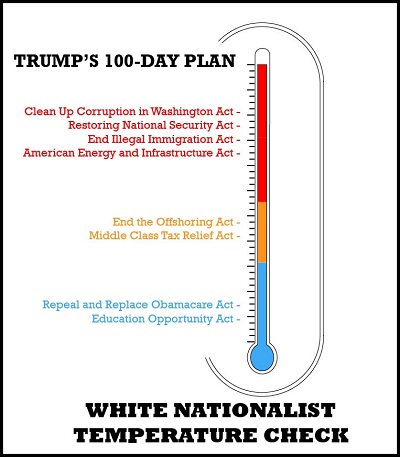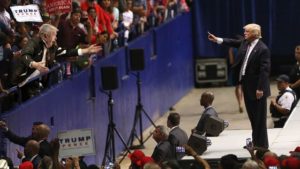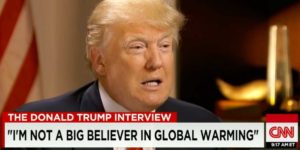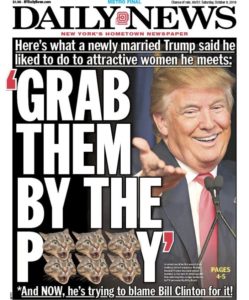Authors: Joan Donovan, Christopher Kelty, Pamela Lim, Won Kyung Oh, Ravneet Purewal, Antoine Rajkovic, and Michael Scheipe —

Illustration by Amisha Gadani
In September of 2015, the Participation Lab at UCLA began researching how white supremacists use genetic ancestry testing to make sense of identity, biology, and human history. We wanted to know what the most extreme, rascist, nazi-sympathizing hatemongers on the Internet thought about the scientific consensus (and subsequent consumer genetic test results) that “we are all African.” While our research involves tracking the ways white supremacists are revising the one-drop rule through the lens of genetics, we have also noted how they engage in current events. For example, during the Republican debates, white supremacists disputed Marco Rubio’s whiteness. Members of these hate groups frequently imagine fresh new hellish utopias of white rule, propose lynching anyone with dark skin, and articulate complicated worldviews concerning dating and reproduction designed not just to preserve, but improve the white race.
So, as we gathered together the day after the election, naturally conversation turned to Trump’s victory. The election had produced a gestalt switch. The racist conspiracies and idle fantasies of reviving the holocaust and the eradication of Native Americans and African Americans (those are the not the words they use, by the way) now looked disturbingly like another reality: Trump’s 100-Day plan.
“White supremacy wish lists” were appearing throughout the message boards: online threads that contain laundry lists of what should change so that the white race can prosper. Lists like these are relatively common on politically themed message boards as users debate the intricacies of policy and society when imagining utopias. Trump’s 100-day plan was posted on his website by the Summer of 2016, and though it appears to have changed occasionally—and will no doubt change over the coming months—it overlaps to a truly nauseating degree with the hopes and dreams of people who are not ashamed to sign off their messages with Nazi slogans.
We wanted to know how we might change the conversation about Trump’s policies if we read them directly through this white supremacist worldview. For instance, framing Trump’s policies through a white supremacist worldview helps us explain the system behind his policies, showing how his platform on immigration, jobs, and climate change articulates something very similar to the white supremacist worldview of isolation and protection from foreign interests.
As we gathered evidence on these issues, we also looked at what white supremacists were calling for that Trump’s 100-Day Plan does not address. Does this mean that such things are beyond the pale even for Trump—or does it simply mean they will have to wait until day 101? For instance, while many are concerned that the appointment of a new supreme justice may lead to overturning Roe V Wade, white supremacists don’t stop there, but call for the repeal of the Violence Against Women’s Act. What else awaits us?
Silencing Dissent: Anti-Corruption and Increased Policing

Trump throws out protester for shouting ‘Beware Hubris!’
Like many conservatives, white nationalists echo the sentiment of small government and chart a course for reducing government by targeting corruption. Trump’s promise to “drain the swamp” by purging corrupt politicians is a throwback to Reagan, who said, “I know it’s hard when you’re up to your armpits in alligators to remember you came here to drain the swamp.” White nationalists believe that most government institutions are criminal and must be overhauled, reformed, or eliminated and as such they want to dismantle government and incarcerate officials. As one poster writes, “Put the whole government in jail and hire all new people.” In Trump’s 100-Day Plan, he says he will end corruption by imposing a hiring freeze on federal employees, set limits on all members of Congress, and remove lobbying and special interests from DC. While white nationalists are suspicious of politicians, they do not seem to be skeptical of the criminal justice system. White nationalists champion the use of jails to punish Trump’s opponents, including “arresting the Clintons for fraud, murder, rape & anything else they can think of.”
While incarcerating corrupt politicians and Trump’s political adversaries is a pathway to limiting government, white nationalists also see increased policing of communities of color as a priority. White nationalists hope that Trump will dismantle the Black Lives Matter (BLM) movement and punish protesters. White nationalists advise Trump to “crack down on BLM” in addition to labeling and treating protesters as “domestic terrorists.” In his 100-Day Plan, Trump calls for a “Restoring Community Safety Act” which would create a task force on violent crime and increase funding for police departments. And this is proposed despite the fact that violent crime rates have remained relatively steady, with only a 1.7% increase from 2014 to 2015 and that the murder rate is the lowest it has been in 50 years. Such demands are a reaction to the BLM Movement’s demand to overhaul the criminal justice system, especially in relation to community oversight and disarmament of police. Without changes to the criminal justice system, Trump’s proposed act would likely amplify the imprisonment of black people.
White nationalists, unlike Trump himself, do not shy away from policy prescriptions: one poster, for instance, suggested that Trump should “label the anti-Trump rioters as domestic terrorists and put them in FEMA camps.” Trump and white nationalists agree that protesters should be punished; the “restoring community safety act” would imprison more black protesters and allow for the systematic oppression of communities of color.
Isolation and Protection: Immigration, Climate Change, and Jobs Policy

Trump’s views on climate change
Unsurprisingly, Trump and white nationalists share strong anti-immigration sentiments. white nationalists desire the removal of all non-white immigrants, particularly Mexicans and Muslims, by force. White nationalists also suggested eliminating sanctuary cities, levying punishments on employers with undocumented laborers, and removing workers with H1B visas because they take jobs from white Americans.
Interestingly, while they oppose immigration and pro-immigration policy, white nationalists encourage immigration from “white” European countries. In this sense, white nationalists are in favor of particular kind of globalism which would make the US a haven for whites only. Trump’s 100-Day Plan calls for the construction of a wall on the southern border, cancelling federal funding to sanctuary cities, renegotiating NAFTA (which issues foreign work visas), “removing the more than two million criminal illegal immigrants,” as well as “suspend immigration from terror-prone regions where vetting cannot safely occur.” When viewed through the lens of a white supremacist worldview, Trump’s policies would simultaneously close the US borders from racialized countries, while opening pathways to immigration from countries where vetting can, one presumes, safely occur. While Trump does not introduce a voter identification law in the 100-Day Plan, it will come to pass as white nationalists believe the democrats are using black people as a shield to block voter reform, one poster speculates about the election, “Democrats [were] getting back in line to vote several times in states that don’t require voter ID.”
White nationalists also agree with Trump on his policies regarding the environment. They favor independence and autonomy from foreign nations by expanding the internal infrastructure of the US to support energy production. Trump’s 100-Day Plan and white nationalists both promote an isolationist platform in which America reaps economic benefits from fossil fuel extraction. White nationalists also call for the destruction of the Environmental Protection Agency and the Bureau of Land Management to reach this goal. Whereas Trump has not committed to eliminating either agency, he nonetheless intends to radically remake the EPA as a haven for climate deniers (proposing Myron Ebell to lead the transition), and he plans on withdrawing from U.N. Climate Change programs. But he has not yet announced who will lead the Department of the Interior, and what the status of vigilantes like Amon and Clive Bundy will be vis-à-vis the federal government.
Trump has said all along that he would cancel the Trans-Pacific Partnership, and White nationalists agree; the TTP would eliminate or reduce tariffs on fossil fuels.
Trump’s plan to reduce the US’s dependency on foreign oil and goods is in line with white supremacist’s worldview of isolationism. In addition, Trump’s jobs policies strengthen the withdrawal from global cooperation on climate change and energy production, all serving to render any trade deal or, perhaps ironically for conservatives, any version of free trade anathema.
Trump plans to “Make America Great Again” by rebuilding infrastructure and increasing access to domestic fuel and manufacturing. White nationalists see Trump’s jobs policy as a way to grow the economic power of working class whites, who they argue have been disenfranchised by international trade. Such policies would bring about a revival of American isolationism and insulate the “white minority” from the global threat of multiculturalism.
Trump’s plan specifies, “lift the restrictions on the production of $50 trillion dollars’ worth of job-producing American energy reserves, including shale, oil, natural gas and clean coal.” Much of Trump’s jobs plan involves the extraction of fossil fuels in the United States to create blue-collar jobs and cease cash flow into the Middle East. Trump plans to reallocate funds from UN climate change programs to infrastructure projects such as the Keystone Pipeline. White nationalists support the repeal of NAFTA and the Trans-Pacific Partnership (“NAFTA on steroids”) because they offshore jobs that would have otherwise gone to white American workers. They are in also clearly in favor of reinstating the Keystone pipeline. Sometimes, however, the white nationalists seem conflicted: for instance, in the case of the Dakota Access Pipeline, they are “not defending those Indians but at the same time… cant support these Corrupt Jew controlled oil companies.” When you hate everyone, it can sometimes be hard to formulate solid policy recommendations.
Women’s Rights

Trump’s infamous statement about women
The patterns of overlap between Trump’s policies and the white supremacist worldview allow us to further envision the agenda for Day 101. During his campaign, Trump was vilified for saying that women who seek illegal abortions “should be subject to some form of punishment.” He later backtracked this statement to say, “The woman is a victim in this case as is the life in her womb. My position has not changed — like Ronald Reagan, I am pro-life with exceptions.” While his campaign promised to defund Planned Parenthood, it does not appear in the 100-Day Plan. He does mention appointing a Judge to replace Scalia and has spoken in the media about wanting a conservative judge that would review Roe V. Wade to limit reproductive freedoms. While white nationalists align with conservatives on family values, they diverge on one key issue; white nationalists do not adhere to a pro-life agenda because they see abortion as an avenue to exterminating non-whites. White nationalists, like Trump, are pro-life with exceptions.
When looking to white nationalists for more insight into what other laws related to women’s rights may be targeted, we found white nationalists support repealing the Violence Against Women Act passed in 1994. This act mandates strong sentencing for repeat offenders of domestic violence and rape. In line with this, white nationalists also favor eliminating family courts, because they believe the system favors women, especially mothers, at the expense of men’s rights. White nationalists would also abolish birthright citizenship, which they believe allows immigrant families to use their children to stay in the country.
And So It Begins…

Anti-Trump Protest in New York City
Right now is an important moment. There is widespread awareness, given the appointment of Stephen Bannon as chief strategist in the coming White House, that white supremacy has come out of the shadows. What used to be an FBI-monitored hate group, could very soon be a wing of the Republican party, and we are at risk—right now—of normalizing the terms “alt-right”, “white nationalist” and even “white supremacist” in ways that are unthinkable for people opposed to racial hatred and violence against non-whites and other minorities, already apparently on the rise in the wake of the election.
What then is to be learned from this comparison? The alarming overlap between Trump’s policy proposals and those of white nationalists is not just a return to the long-standing demands of the right, it is quite clearly something new in our political history. This is not simply a return to the racism and white superiority of an America of the past, but a range of proposals for re-making America into something we’ve never seen before, and which we have to believe, a majority of people really do not want. A world of race-hatred, isolationism, fossil-fuel-driven infrastructure policy, and climate denial is beyond what any thoughtful Republican would ever advocate for, but here we are.
It is disturbing in itself to read what white nationalists, or should we say white Americans, believe—stomach churning hatred fills every page, and in doing our research, all of us have found it overwhelming and upsetting at regular intervals. But even more disturbing would be the accomplishment of the goals of the White Supremacist Movement without any of the language or rhetoric. What if instead of saying “let’s make America great again” we said “let’s make America white again”? It’s important to keep repeating what exactly “great” now means: silencing dissenters, jailing political rivals and those who protest those in power, violently policing communities of color, closing the borders and jailing those who cannot be sent away, isolating the US from global negotiations on climate change and trade, creating jobs by manufacturing fossil fuels to protect the US from foreign competition, and restricting women’s rights. That may sound like the America of the past, but it is not—and it we cannot let it become the America of the future.
Gabriella Coleman recently circulated a paper on “fake news,” where she suggests that the problem of journalism today is not one of truth and lies, but rather we lack a way to analyze compelling stories. Trump was able to weave together facts with fantasy that made it difficult to pry them apart. And, nor should we bother. Quoting journalist Karl Bode, she agrees, “Reality needs a better PR department.” Each plank of Trump’s platform can be read as its own conspiracy theory, but when taken together, it is a paradigm of white power told to us as a parable of prosperity. This is why it’s been difficult for us to write about white supremacists’ use of DNA tests, where they use genetics to make claims about why whiteness should be protected. Geneticists and the companies selling these tests, most likely, are not even aware of how this technology is giving white supremacists new ways to narrate the one-drop rule. In a few weeks, we will post an update on this project.
Lastly, we also cannot ignore that Trump’s victory has been pinned on the working class, which is true if you pretend only whites belong to the working class. Many educated white folks with college degrees were able to overlook Trump’s numerous racist and sexist remarks to vote in their self-interest. With that in mind, we leave you with a quote, dear reader, from Fred Hampton, who said, “You can have as many degrees as a thermometer, [but] if you don’t have any practice, then you can’t walk across the street and chew gum at the same time.” For Hampton, practice means education; that steady combination of observation, critique, and doing the work in community with others.
